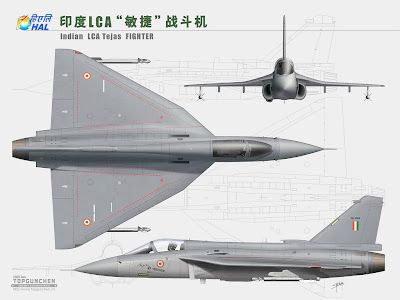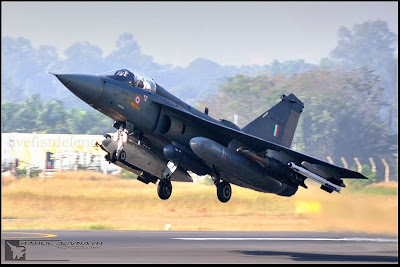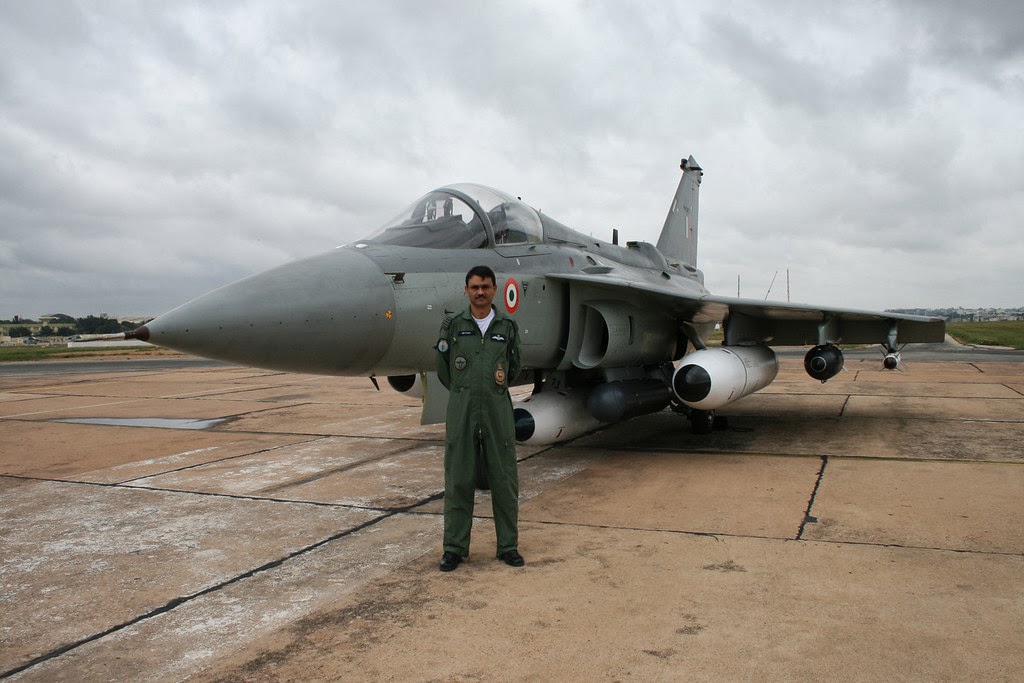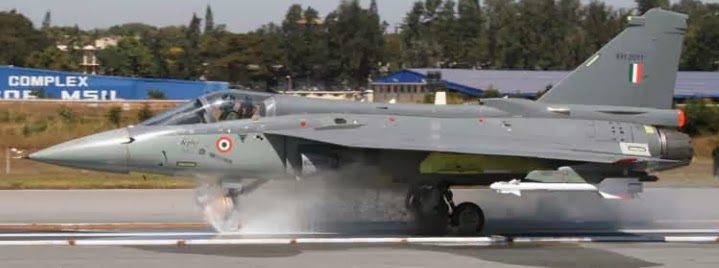http://player.vimeo.com/video/115703506?title=0&byline=0&portrait=0
Tejas with double delta &Mirage with single delta configuration.
Additional pages
on tejas.gov.in
begin with the premise that I understand the word "good" as a relative term.
Seven safety critical and Twenty Three mission critical software systems of Tejas have been evaluated and close to 2000 successful sorties of Tejas have been completed adhering to IV&V practices. How good the LCA will depend on the situation and type of mission (SEAD, DEAD) that it is entrusted with .
Special features of Tejas:
1. Compound delta platform.
2. Relaxed Static Stability (RSS).
3. Composite structure (which constitute 43% by weight of the airframe)
4. Fly by wire flight control(FBW).
5. Utilities system management software(USMS).
6. Glass cockpit.
7. Multi Mode Radar radar was a Hybrid version of Israel’s Elta EL/M-2032 for all weather operations.
LCA is better than JF17 & MIG-21 in number of ways.
First, there is generation gap. LCA is 4.5 generation aircraft while JF17 (3.5 Gen. using Mig21 Titanium 1955 era Airframe) & MiG 21 are of 3rd gen. JF17 is an all metallic warplane with no fly by wire controls means the pilot will have more work load to fly the aircraft. Cost-effectiveness and weight saving achieved by use of advanced composites which constitute 43% by weight of the airframe. Also it can perform high alpha & better maneuverable than JF17.
Second, LCA got better & tested avionics than JF17.
Third, unlike JF17 OR MiG21 Bison. LCA Tejas is a multirole fighter and is very light in weight. It can perform at high alpha and has better maneuverability. Optimized Structural Design taking into account strength, buckling and Aero-Servo-Elastic requirements for carriage of heavy ext. stores.
LCA uses carb-composites in its airframe hence it has got a stronger body than JF17. It reduce 1000s of screws & its weight.
It has RSS (relax static stability) in it unlike JF17 OR Mig21.
It has digital fly-by-wire Flight Control. The new generation glass cockpit (& NVG) comprises Multi Function Displays (MFD), Head Up Display (HUD) and Stand by Inst. System driven by Open Arch. Mission and Display Computer.
Moving towards certification for FOC.
Electronics and Radar Development Est (ERDE) is working on a much advance Active Electronically Scanner Array radar (AESA).
According to official updated material made available to
LiveFist,the fully solid-state X-band radar with ACM/SAR/ISAR are being developed.
Unlike Tejas JF-17 is not all weather capable and also not fully developed by Pakistan. Where as Tejas is fully developed in india although some vital parts like Engine are imported.
When it comes to Radar detection JF-17 will have larger rcs where as Teajs will have less because of the carbon comp. body structures!!
Tejas have modern glass cockpit and continiously evolving according to airforce needs. The FOC standard Tejas will have inflight refuelling, BVRs, capability to carry st-off missiles, all kind of conventional and sm-bombs which IAF posses.
The FOC standard Tejas will be a MultiRole all weather 4.5++ aircraft. But JF-17 doesnt have this kind of all round capabilities. Moreover it is a 30 years research product where as JF17 produced under a short span of time. There can be various flaws in design &during flight.
The max. projected weapons payload for the LCA (distributed among seven pylons) is 3.5 tonnes
. In the CAS role, the LCA MK1 will be required to target mostly hostile field artillery emplacements & probably some hostile second-echelon armoured regiments. Usage of 100kg/150kg laser-guided PGMs is the only viable option for such strikes. Similarly, for LCA MK1s tasked with defensive counter-air missions inside friendly airspace & tactical air-superiority missions in support of CAS strikes, usage of dual-ejector racks for R-73E WVRAAMs & Derby MRAAMs along with twin external fuel-tanks is the only viable option.
If the enemy IADS is dense and overlapping like in the case of China the LCA will have a hard time in penetrating it. So , the obvious question would be what constitutes a credible IADS ?
A credible IADS, need three things:
1.
Sensors: radar is obvious, but this can include other detection systems like IR sensors, passive detectors, and so on.
2.
Weapons: AAA, SAMs, interceptors...you need some way of stopping people from getting into your airspace.
3.
C3 network: this is what makes the whole thing integrated, providing functions like situational awareness and target de confliction.
The complexity of the whole system and the individual components depends on the volume of airspace you want control over and the perceived threat. But a few S-300PMU-2 batteries coupled with a battle mngmnt. radar system capable of talking to the overall EW network makes things a whole lot different. In India's immediate neighborhood
only China boasts of all these above 3 things.
The max. projected weapons payload for the LCA (distributed among seven pylons) is 3.5 tone
. In field artillery emplacements & probably some hostile second-echelon armoured regiments. Usage of 100kg/150kg laser-guided PGMs is the only viable option for such strikes. Similarly, for LCAMK1s tasked with defensive counter-air missions inside friendly airspace & tactical air-sup. missions in support of CAS strikes, usage of dual-ejector racks for R-73E WVRAAMs & Derby MRAAMs along with twin external fuel-tanks is the only viable option.
With no SAMs deployed in a theatre, the effectiveness of visually aimed and radar directed AAA is poor, as aircraft can attack unhindered from medium and high altitudes, out of the useful envelope of barrelled weapons. The corollary to this is , in a SAM rich environment where AAA would be absent, aircraft can attack unhindered from low altitudes, exploiting terrain masking and performance limitations in SAMs &radar systems. AAA's are also more difficult to kill, camouflage and emission control. Therefore ,
how good or bad the LCA is will depend what the adversary has in store in terms of SAMs , AAA and of course fighter aircrafts .
Limited Series Production (LSP) aircraftCurrently, 8 LSP series aircraft plus 40 aircraft are on order.
- LSP-1 (KH2011) – 25 April 2007. This LCA is powered by F404-F2J3 Engine.
- LSP-2 (KH2012) – 16 June 2008. This is the first LCA fitted with F404-IN20 engine.
- LSP-3 23 April 2010. The first aircraft to have the Hybrid MMR radar and will be close to the IOC standard.
- LSP-4 (KH2014) – 2 June 2010. The first aircraft that was flown in the configuration that will be delivered to the Indian Air Force.In addition to the Hybrid MMR, the aircraft flew with a Countermeasure Dispensing System and an identify friend or foe electronic system
- LSP-5 (KH2015) – 19 November 2010. IOC standard, with all sensors including night lighting in the cockpit, and an auto-pilot.[
- LSP-6 – Will be used to increase the Angle of Attack.As well as develop better (Experimental) RAM coating to further reduce its radar signature.
- LSP-7 (KH2017) – 9 March 2012. APU intake has been aerodynamically reshaped.
- LSP-8 – First flight trial completed in March 2013. LSP 8 is the version that will go for production
- SP-1 to SP-40 – Planned to fly by late 2013. The SP-1 and SP-2 will be part of No. 45 Squadron (Flying Daggers) that will be based initially in Bangalore (Bengaluru). In May 2014, HAL planned to deliver four SP aircraft to the IAF. SP-1 took its maiden flight on 30 September 2014.
Performance
- Maximum speed: Mach 1.6 (1,350 km/h) calibrated airspeed (CAS) at high altitude, reached in testing of IOC-I, theoretically capable of Mach 1.8
- Range: 3,000 km (1,620 nmi, 1,864 mi)
- Combat radius: 300 km (162 nmi, 186 mi)
- Ferry range: 1,700 km (1,056 mi)
- Service ceiling: 15,240 m (50,000 ft)
- Wing loading: 247 kg/m² (50.7 lb/ft²)
- Thrust/weight: 1.07
*** Glossary Of Terms ***
SEAD – Suppression Of Enemy Air Defenses
DEAD – Defeat of Enemy Air Defenses
IADS - Integrated Air Defense System
AAA – Anti Aircraft Artillery
C3 – Command Control Communication
CAS - Close Air Support
WVRAAM – Within Visual Range Air to Air Missile
MRAAM - Medium Range Air to Air Missile
LPI – Low Probability of Intercept
IV &V Ind. Verification & Validation
SAM - Surface to Air Missile
NVG - Night Vision Goggle

















+Tejas+(2).jpg)





